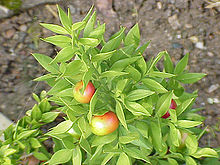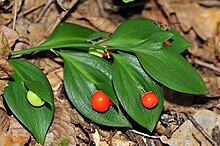You can help expand this article with text translated from the corresponding article in Polish. (May 2022) Click for important translation instructions.
|
| Ruscus | |
|---|---|

| |
| Ruscus aculeatus | |
| Scientific classification | |
| Kingdom: | Plantae |
| Clade: | Tracheophytes |
| Clade: | Angiosperms |
| Clade: | Monocots |
| Order: | Asparagales |
| Family: | Asparagaceae |
| Subfamily: | Nolinoideae |
| Genus: | Ruscus L. |
| Synonyms | |
| |
Ruscus, commonly known as butcher's broom, is a genus of six species of flowering plants, native to western and southern Europe, Macaronesia, northwestern Africa, and southwestern Asia east to the Caucasus. In the APG III classification system, it is placed in the family Asparagaceae, subfamily Nolinoideae (formerly the family Ruscaceae). Like many lilioid monocots, it was formerly classified in the family Liliaceae.
The species are evergreen shrub-like perennial plants, growing to approximately 1 metre (3 ft 3 in) tall. They have branched stems that bear numerous cladodes (flattened, leaf-like stem tissue, also known as phylloclades) 2 to 18 centimetres (0.79 to 7.09 in) long and 1 to 8 centimetres (0.39 to 3.15 in) broad. The true leaves are minute, scale-like, and non-photosynthetic. The flowers are small, white with a dark-violet centre, and situated on the middle of the cladodes. The fruit is a red berry 5 to 10 millimetres (0.20 to 0.39 in) in diameter. Some species are monoecious while others are dioecious.
Ruscus is spread by seed and by means of underground rhizomes. It can colonise extensive patches of ground.


Utilitarian Significance
Medicinal plants


History
Various species of butcher's broom has been used for medicinal purposes since antiquity. The first mentions of the medicinal use of the butcher's broom come from ancient Greece. The rhizomes of this plant were used to treat inflammations, hemorrhoids, and urinary tract conditions, as well as a diuretic and laxative. In the 1st century De Materia Medica by Dioscorides, the plants described are: ύπόγλοσσον (ypoglosson), probably Ruscus hypoglossum, ιδαια ριζα (idaia riza), also probably R. hypoglossum and μυρσίνη άγρία (myrsini agria), probably R. aculeatus. Dioscorides indicated the laxative and diuretic effects of these plants. Pliny the Elder in his Natural History pointed out the use of these plants in treating varicose veins. In the Herbal of Simon Syreński, first published in 1613, the butcher's broom is described as a plant with healing power, for use in urinary retention, kidney stones, and accelerating menstruation, mainly in the form of a wine tincture. Also, in the 17th-century work Janua linguarum reserata by Comenius, the butcher's broom was described as a warm herb for kidney diseases. In the 1852 work Special Botany: Description of Monocotyledonous Medicinal and Industrial Plants by Ignacy Czerwiakowski, the author reported that the root of butcher's broom (radix Rusci v. Brusci) was formerly used as "an opening and diuretic agent in dropsy and blockages of the viscera", part of the herbal mixture radices quinque aperientes majores (five major opening roots), and also used in treating jaundice and kidney stones, and to accelerate menstruation. The author also mentioned that the root of R. hypophyllum had medical applications, including in difficult births, retention of menstruation, and urinary system conditions. In the case of R. hypoglossum, Czerwiakowski mentioned the use of this plant's herb for throat and uterine conditions.
Indications
Butcher's broom is used in traditional medicine in many countries around the Mediterranean Sea. In Europe, the underground parts are traditionally used in the treatment of urinary system conditions and as a laxative, while the aboveground parts are mainly used as diuretics. In folk medicine in Turkey, a decoction of the roots of butcher's broom is widely used internally as a diuretic and for treating urinary system conditions, such as kidney inflammation and kidney stones, as well as for treating eczema. In Palestine, an extract from the rhizome is used externally for skin diseases, while in Italy it is used in treating warts and frostbite, with inflammatory bowel diseases and diarrhea, and topically in joint inflammation. The aboveground parts of the plant are traditionally used as diuretics, mainly in Mediterranean countries and the Middle East. In Turkey, a decoction of the berries of Ruscus hypoglossum is used externally for boils and warts, and fresh leaves are used in cattle breeding against colds and mastitis. The leaves of R. colchicus are used by the local population for feeding farm animals to increase milk production and fat content. Ruscus hyrcanus is used in traditional Iranian medicine as a diuretic, hemostatic, vasoconstrictor, antimicrobial, and anti-inflammatory agent.
Current Use
Presently, butcher's broom is not widely used in modern medicine due to a lack of comprehensive clinical studies proving its effectiveness. However, extracts of this plant are found in some pharmaceutical and cosmetic products, such as creams for varicose veins and hemorrhoids. Preparations of the plant are also used in homeopathy. Some recent studies have indicated that the plant may have potential pharmacological effects, such as anti-inflammatory, antimicrobial, and antioxidant activities. These studies suggest the possibility of its future application in modern medicine, especially in diseases related to inflammation and oxidative stress.
Species
- Ruscus aculeatus (butcher's broom). Europe, Azores.
- Ruscus colchicus Caucasus.
- Ruscus hypoglossum Central and Southeast Europe, Turkey.
- Ruscus hypophyllum (spineless butcher's broom). Iberia, northwest Africa. Used in the floral trade as foliage.
- Ruscus hyrcanus Woronow An endemic and relict bush in the Talish Mountains, Azerbaijan. Protected in the Hirkan national Park.
- Ruscus x microglossus Southern Europe.
- Ruscus streptophyllus Madeira.
References
- ^ Kew World Checklist of Selected Plant Families
- Chase, M.W.; Reveal, J.L. & Fay, M.F. (2009), "A subfamilial classification for the expanded asparagalean families Amaryllidaceae, Asparagaceae and Xanthorrhoeaceae", Botanical Journal of the Linnean Society, 161 (2): 132–136, doi:10.1111/j.1095-8339.2009.00999.x
- Matej Barbic. "Isolation and identification of the constituents from Ruscus aculeatus L. and their in vitro activity". Retrieved 2021-09-24.
- ^ Dioskurydes, Pedanios (2005). De materia medica. Lily Y. Beck (tłum.) (1 ed.). Olms-Weidmann. ISBN 3487128810.
- Dioskurydes, Pedanios (2017). De materia medica. Lily Y. Beck (tłum.) (3 ed.). Georg Olms Verlag. ISBN 9783487155715.
- Bone, Kerry; Mills, Simon (2013). Principles and practice of phytotherapy: modern herbal medicine (2 ed.). Edinburgh: Elsevier Health Sciences. p. 467-472. ISBN 9780702052972.
- Saad, Bashar (2011). Greco-Arab and Islamic Herbal Medicine : Traditional System, Ethics, Safety, Efficacy, and Regulatory Issues. Hoboken, N.J.: Wiley. ISBN 9781118002261.
- Syreński, Szymon (1613). Zielnik. Kraków.
- Komenský, Jan Ámos (1768). Janua aurea reserata duarum linguarum. Wilno: Scholarium Piarum.
- Ignacy Rafał Czerwiakowski (1852). Botanika szczególna (in Polish). Vol. 2 Opisanie roślin jednolistniowych lekarskich i przemysłowych. Kraków: Uniwersytet Jagielloński. p. 613-615.
- ^ Rodrigues, Joana P. B. (2021-03-26). "Phenolic Compounds and Bioactive Properties of Ruscus aculeatus L. (Asparagaceae): The Pharmacological Potential of an Underexploited Subshrub". Molecules. 26 (7) (7 ed.): 1882. doi:10.3390/molecules26071882. hdl:10198/24369. PMC 8037534. PMID 33810432.
- ^ Masullo, Milena; Pizza, Cosimo; Piacente, Sonia (2016-11-08). "Ruscus Genus: A Rich Source of Bioactive Steroidal Saponins". Planta Medica. 82 (18) (18 ed.): 1513–1524. doi:10.1055/s-0042-119728. PMID 27825178.
- P. F. Yeo (1966). "Two New Species of Ruscus (Liliaceae)". Feddes Repertorium. 73 (1): 17–20. doi:10.1002/fedr.19660730103.